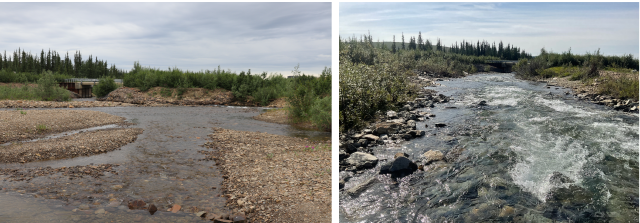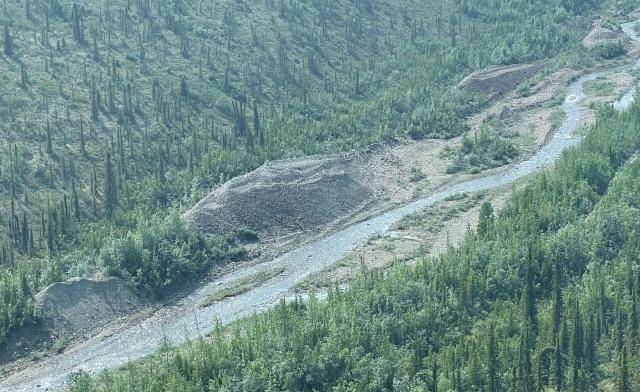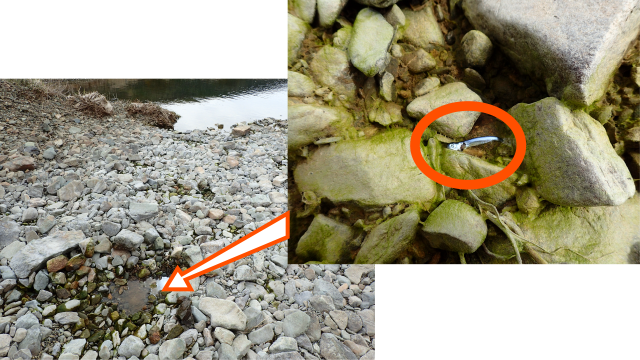
Pacific Salmon Resiliency
Habitat Rehabilitation and Restoration
BLM-managed public lands in the upper Yukon River portion of Alaska have been the focus of applied research and the application of new techniques regarding stream reclamation since 2013. Many stream reclamation focused demonstration projects have been implemented over the last ten years and serve as outdoor classrooms for agency staff, industry stakeholders, and the public. The BLM host tours of stream restoration accomplishments on Nome Creek and Wade Creek upon request and will continue to coordinate opportunities where project partners can share updates and increase collaboration. The BLM also developed several resources to improve project success across the region including the publication of an interagency Stream Design Guide and Stream Reclamation Basics brochure. Despite these successes, significant habitat rehabilitation opportunities remain.
The BLM continues to refine stream rehabilitation techniques while improving riverscape health through targeted restoration work across the BLM Restoration Landscapes (Restoration Landscapes | Bureau of Land Management) in the upper Yukon River region. The bureau’s expanded work within other areas of Gravel to Gravel (Norton Sound, Yukon, and Kuskokwim regions) started this year and will continue into the future. Details about these projects below
Wade Creek Watershed
Wade Creek is a tributary of the Walker Fork in the Fortymile Wild and Scenic River corridor and has a rich history of placer mining dating back to the mid-1800s. It is accessible by the Taylor Highway and visitors to the area can enjoy spectacular vistas overlooking tributaries of the Fortymile River and learn about the region’s mining history at the Tok Visitor Center and in the community of Chicken. Wade Creek and other streams of the Fortymile watershed support sport fisheries for Arctic grayling and provide diverse boating opportunities (Fortymile Wild and Scenic River | Bureau of Land Management).
Evidence of current and historic placer mining in the Wade Creek watershed can be seen by visitors and anglers traveling through the area. Large creek sections are on closed federal claims, which can no longer be mined due to their location within the Fortymile Wild and Scenic River unit. Even so, decades after mining ceased, these areas remain degraded.
Numerous sections of Wade Creek have been treated to improve habitat conditions since 2015. Restoration efforts along Wade Creek are challenging due to a mix of existing (recorded) and closed federal mining claims and constraints imposed by the Taylor Highway which parallels the creek along the valley bottom.
All BLM-funded habitat enhancement projects have improved stream function except one project that failed during a high-water event three years after construction. That failure added to the bureau’s knowledge and, paired with other project successes, has helped refine our restoration techniques over time.
Wade Creek’s degraded conditions contribute to repeated closures and on-going maintenance of the Taylor Highway. Habitat rehabilitation work in collaboration with Alaska Department of Transportation is expected to improve stream conditions within the watershed and reduce impacts to existing highway infrastructure
We are continuing our work to rehabilitate habitats on closed federal claims within the Wade Creek watershed and expand outreach to the many visitors traveling the Taylor Highway. BLM is implementing a strategic and stepwise approach to restoration by focusing on the headwaters and progressing downstream. Reducing erosion and sediment inputs to the stream from historic mine tailings in the upper watershed is a key emphasis, while also focusing on rehabilitating instream habitats and improving floodplain revegetation where appropriate. A comprehensive long-term monitoring program will assess the effectiveness of restoration within the watershed. The Taylor Highway parallels Wade Creek for most of its length, so the BLM is working with stakeholders to develop information kiosks that will help tell the mining history of the area, as well as the challenges associated with restoring stream and floodplain conditions.
Nome Creek Watershed
Nome Creek supports a popular grayling fishery in the White Mountains National Recreation Area and is a major tributary of the Beaver Creek Wild and Scenic River. This area often sees high levels of visitation due to the nearby BLM designated campgrounds (Ophir Creek and Mt. Prindle), and recreation opportunities, such as hiking, gold-panning, and boating (White Mountains National Recreation Area | Bureau of Land Management).
Like Wade Creek, Nome Creek has a rich history of placer mining and is the focus of several habitat improvement projects. Much of the past work is summarized in BLM Open File Report 113 (BLM 2007). Much like Wade Creek, this project seeks to continue the stabilization of closed federal claims and abandoned mine lands in the watershed and address stream alignment issues which contribute to erosion of the Nome Creek Road and risks to the bridge crossing. Unlike Wade Creek, Nome Creek has limited infrastructure in the valley and no remaining federal mining claims.
Initial work began in 2023 with over 1,000 feet of stream channel restored to enhance habitats for Arctic grayling using a combination of proven techniques and experimental methods. The project included channel realignment to reduce impacts to the road and bridge supports. Work to restore both stream and floodplain conditions using a variety of various methods began in 2024 and will continue into the future. Like Wade Creek, the BLM developed a comprehensive monitoring program to assess the effectiveness of restoration along the 8-miles of stream planned for treatment.
Harrison Creek Watershed
Harrison Creek is a major tributary to the Birch Creek National Wild and Scenic River and is partially located in the Steese National Conservation Area. It was extensively placer-mined for gold starting in the late 1890s and contains a mixture of existing (recorded) and closed federal mining claims.
In 2001, BLM initiated restoration efforts in the Harrison Creek watershed but only completed restoration work on 1.5 miles of stream due to limited funding. The 2016 Steese Resource Management Plan identified Harrison Creek as a High Priority Restoration Watershed noting that biological and physical processes and functions do not reflect natural conditions because of past and long-term human-caused land disturbances.
The Harrison Creek project continues restoration of approximately 10-miles of placer-mined stream channel on abandoned mine lands within the watershed. Starting in 2024, BLM initiated a multi-year project to assess conditions and begin development of a restoration treatment strategy.
Salmon River Watershed
The Salmon River drains to Kuskokwim Bay in Southwest Alaska and is accessible by road from the community of Platinum. All five species of Pacific Salmon use this watershed and a USFWS weir has operated at the mouth of the river since 2023. Chum, pink, and sockeye salmon return in the 1000s and peak run timing occurs in late July to early August for all species except for coho, which return in late August.
The Salmon River drainage has been mined nearly continuously since 1927 when hand mining operations began in the shallow gravels of Salmon River tributaries. In 1934, a new operator shipped equipment and supplies necessary to set up a complete and self-sufficient modern mining camp to Goodnews Bay. Early in 1935 the Goodnews Bay Mining Company was incorporated, consolidating and acquiring title to over 150 claims. A dredge was purchased in 1937, which allowed the mining of deep reserves of platinum and considerably more ground.
Tailings were discharged from the dredge by a 140-foot-long stacker, which created formidable tailing piles. During World War II, when most gold mining operations were shut down, the platinum mined by the Goodnews Bay Mining Company was listed as critical and the mine was one of few that continued to operate through the war.
The Goodnews Bay platinum mine produced about 650,000 ounces of platinum. The dredge and dragline created about 44 million cubic yards of tailings and waste rock; the magnitude of which is difficult to comprehend. The 44 million cubic yards of tailings would cover the area of a football field over 27,000 feet deep, exceeding the vertical height of Mt. McKinley!
The extensive tailings in the Salmon River watershed block salmon migrations in the mainstem during summer low flows and permanently block access to some tributaries. According to the USGS National Hydrography Dataset (NHD), the drainage network comprises 59 miles of streams. Currently, during the summer months, fish only have access to approximately 7 miles of stream habitat. Observations along the intermittent sections of stream found blocked adult migrations to spawning areas and mortality of rearing juveniles.
In collaboration with partners, the BLM and USFWS are planning a multi-year effort to close key data gaps necessary to develop a restoration plan that improves watershed conditions and provides salmon and other fish species full access to spawning and rearing habitats.
In 2025, BLM worked with the Salcha-Delta Soil and Water Conservation District to collect LiDAR data for much of the Salmon River watershed. This information will be foundational to restoration planning intended to improve fish passage and overall watershed condition. Additionally, BLM staff spent about a week on site collecting data to understand the range of conditions present along the Salmon River and its tributaries, as well as in adjacent watersheds. The collected information will be summarized in early 2026 and help inform restoration plan development and future treatment actions.








